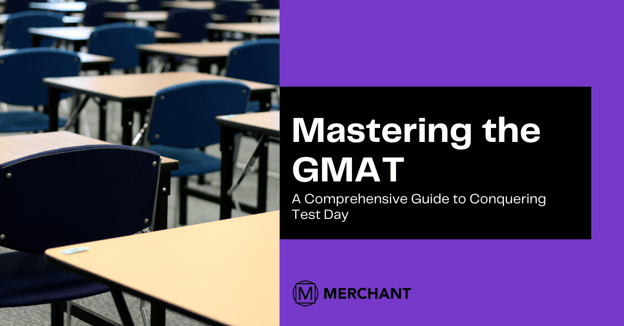
Every year, business school hopefuls spend significant amounts of time, money, and effort in order to perfect their MBA program applications and enter the competitive world of business school admissions. While your experiences, resume, and background are key aspects of your application, one of the first ways to stand out as a competitive MBA candidate is to prove your business aptitude by scoring well on the GMAT exam. The phrase “standardized test” alone is enough to intimidate even the strongest of applicants, but never fear; with proper preparation, you can gain an edge on the competition and conquer the GMAT! The first step is to familiarize yourself with the exam:
What is the GMAT?
The GMAT, or the Graduate Management Admissions Test, is a standardized exam unlike any other. The exam is almost four hours long and is taken by over 200,000 aspiring MBA students annually. The GMAT is designed by psychometricians, built to test an MBA candidates’ business skills (analytical, writing, quantitative, verbal, and reading) and serves as an indicator of how well a business school applicant will perform in their MBA program. Over 2,300 graduate schools around the world use GMAT scores as a factor in admissions. Achieving a high score on the GMAT will have a positive impact on your likelihood of admission into the MBA program of your dreams.
What is the Format of the GMAT?
The thing to remember about the GMAT is that it isn’t testing how good at math you are or how well you understand the English language. Basic math skills and English comprehension are key to doing well on the exam, but you don’t need to be a calculus whiz or a best-selling author in order to score high! The GMAT aims to assess how well you solve problems using logic, especially under time constraints. With under two minutes to answer each question, the test also gauges how well you perform under time pressure and with limited resources.
The exam is separated into 4 different parts:
- Analytical Writing Assessment (1 Question, 30 mins): aimed at measuring your critical thinking and communicative abilities
- Question types: Analysis of Argument
- Integrated Reasoning (12 Questions, 30 mins): tests your ability to synthesize and draw conclusions from data
- Question types: graphics interpretation, table analysis, multi-source reasoning, two-part analysis
- Quantitative (31 Questions, 62 mins): focused on testing your problem solving skills using basic mathematical abilities (don’t worry- you only need to know up to high school math!)
- Question types: data sufficiency, problem solving
- Verbal (36 Questions, 65 mins): assesses your problem solving strategies and reading comprehension abilities
- Question types: reading comprehension, critical reasoning, sentence correction
On the day of your exam, you will be able to decide in which order you want to take the different sections. Another key aspect of the exam: you are unable to skip questions.
How is the GMAT Scored?
Each section of the GMAT has a specific scoring mechanism. The scoring breakdown for the AWA and Integrated reasoning portion is as follows:
- The Analytical Writing Assessment is scored separately from the other sections on a scale from 0-6, reported in intervals of 0.5.
- The Integrated Reasoning portion is scored separately as well on a scale from 1-8, in intervals of 1. Your score in this section depends on the number of questions answered correctly. You must answer all parts of each multi-part question correctly in order to receive points.
However, most business schools will focus on your Quantitative and Verbal scores. The Quant and Verbal segments (scored from 0-60) are combined in order to generate your GMAT score, which will fall on a scale between 200-800. The mean score for all GMAT test-takers is around 552. When identifying your target GMAT score, it is a good idea to research the mean score of admitted applicants in the programs you are applying to. Here are some factors that are taken into account when scoring your exam:
- The Quantitative and Verbal sections are item-level adaptive and your score will be based on the following
- The number of questions you answer
- Whether you answered correctly
- The difficulty of the questions
What is a CAT?
In the GMAT world, a CAT stands for computer adaptive test. Only the Quantitative and Verbal sections of the exam are computer adaptive. This means that the difficulty of the questions you see will depend on your previous correct or incorrect answers. For instance, if you answer a question correctly, your next question will be more difficult. If you answer that question incorrectly, you will receive an easier subsequent question. However, your score will take into account the difficulty of questions you answered correctly or incorrectly. Think about it this way: Person A could get more problems incorrect than Person B, but Person A could still get a higher score because they saw more difficult problems. You must answer each question before you can go on to the next one, and you may not go back to change your previous answer. Finally, leaving a question unanswered results in an even larger penalty than answering incorrectly.
When Should I Take the GMAT?
It is best to begin identifying and researching your MBA programs of interest as early as possible in order to ensure that you remain up to date with deadlines. You may take the exam up to 5 times in one 12-month period. Additionally, you will need to allocate enough time for your GMAT exam to be scored so that it may be reported on time to your MBA programs of choice.
While your unofficial report will be available immediately following your exam, it will take 20 days for your official score report to be generated. Prior to the start of your exam, you can select 5 schools that you would like your official score report to be sent to (included in your registration fee). Once you have selected your schools, they cannot be changed. For an additional fee, you may send your report to other schools (not selected on the day of testing) as well. Your GMAT score is valid for 5 years after you take the exam.
As you may know, many MBA programs offer application rounds: Round 1 in September/October, Round 2 around January, and Round 3 around April. If you are applying in Round 1, for instance, it is best to have taken your exam at least 2-3 months before the application deadline if you would like to err on the side of caution. However, as long as you complete the GMAT at least 1 month before the deadline you should have ample time to get your scores in by the deadlines. With most schools you can apply with your current score and send an updated score a few weeks after the deadline.
Another thing to consider is the amount of time you will need to spend studying for the exam. In general, the top-scoring GMAT test takers will spend about 120 hours (3-6 months) or more preparing for the exam. Remember, the best way to “beat” the exam is to be well-prepared!
Where can I take the GMAT?
The GMAT is offered at test centers around the world (Click here to find a test center near you). Some test centers even offer special accommodation rooms. The exam is offered very frequently throughout the year (most days except for holidays) but can fill up quite fast, so check your closest test center to determine availability.
How can I Register for the GMAT?
In order to take the exam, you first must register on mba.com, the official website of GMAC. You will also need to pay the registration fee of about $275 (US), but the price may vary depending on your location (see GMAT Location Specific Pricing). Additionally, you will need a valid form of identification.
What do I do Now?
We know that the MBA admissions process can be overwhelming, but here at Merchant GMAT & Admissions, we are here for you every step of the way! Click here to begin your MBA journey today.



%20(1).png?width=624&height=427&name=Extended%20Time%20on%20GMAT%20(300%20%C3%97%20175%20px)%20(1).png)
.png?width=624&height=427&name=Micro%204%20-%20Nano%205%20(300%20%C3%97%20175%20px).png)